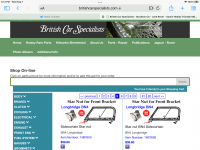RAC68
Darth Vader
Offline
Hi All,
I attended a meeting of The Austin Healey Sports & Touring Club and was pleasantly surprised by a presentation on 3D Printing by Steven Dibdin, owner of Additive Restoration. Steven explained that 3D printing is moving forward quite quickly and, as opposed to common manufacturing (as in milling and machining), takes an additive approach with Selective Laser Sintering used to melt and solidify layers of powered material into solid finished components.
As an example, Steven presented a dual point ignition rotor that he created for a Maserati OSCA racing car. As one of less than a handful worldwide, this late ‘50s car had no source for this part and its owner had no easy way of having one produced. Steven started by creating a digital design of the part and also modeled the cap. He then viewed the rotor’s operation within the cap and discovered that the spacing of cap terminals to each of the 2 rotor contacts was differed. To rectify this condition, he altered the design to even the spacing. His first phase of 3D printing was to form the contact component from sintered brass with the second phase to form the insulator around the brass. As a result, this complex part was produced with greater quality and reliability … just what we have been missing for many in Healey parts.
Steven explained that 3D printing is not a singular approach and the expansion of materials and types of lasers can now produce a broad range of One Off components larger then fenders and engine heads to others smaller than a human cell. As a result, actual (3D) printing is often outsourced with such organizations as Steven's providing computer aided design and plan services.
The 6 units made by Steven cost the OSCA owner $600 each and, although this seems expensive, when compared to the value of the car and the fact that there was no source for a replacement, the price was not out of line. This is a growing approach and, although presently expensive, prices for demand-quantities are dropping fast and could become a quality source of parts for our Healeys.
Thoughts?
Ray(64BJ8P1)
I attended a meeting of The Austin Healey Sports & Touring Club and was pleasantly surprised by a presentation on 3D Printing by Steven Dibdin, owner of Additive Restoration. Steven explained that 3D printing is moving forward quite quickly and, as opposed to common manufacturing (as in milling and machining), takes an additive approach with Selective Laser Sintering used to melt and solidify layers of powered material into solid finished components.
As an example, Steven presented a dual point ignition rotor that he created for a Maserati OSCA racing car. As one of less than a handful worldwide, this late ‘50s car had no source for this part and its owner had no easy way of having one produced. Steven started by creating a digital design of the part and also modeled the cap. He then viewed the rotor’s operation within the cap and discovered that the spacing of cap terminals to each of the 2 rotor contacts was differed. To rectify this condition, he altered the design to even the spacing. His first phase of 3D printing was to form the contact component from sintered brass with the second phase to form the insulator around the brass. As a result, this complex part was produced with greater quality and reliability … just what we have been missing for many in Healey parts.
Steven explained that 3D printing is not a singular approach and the expansion of materials and types of lasers can now produce a broad range of One Off components larger then fenders and engine heads to others smaller than a human cell. As a result, actual (3D) printing is often outsourced with such organizations as Steven's providing computer aided design and plan services.
The 6 units made by Steven cost the OSCA owner $600 each and, although this seems expensive, when compared to the value of the car and the fact that there was no source for a replacement, the price was not out of line. This is a growing approach and, although presently expensive, prices for demand-quantities are dropping fast and could become a quality source of parts for our Healeys.
Thoughts?
Ray(64BJ8P1)
Last edited:

 Hi Guest!
Hi Guest!

 smilie in place of the real @
smilie in place of the real @
 Pretty Please - add it to our Events forum(s) and add to the calendar! >>
Pretty Please - add it to our Events forum(s) and add to the calendar! >> 




